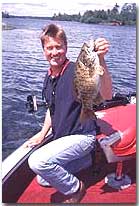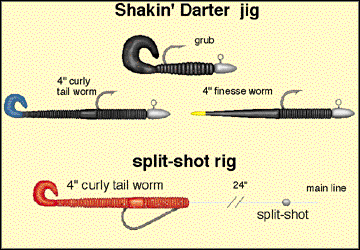Western Tactics for Eastern Bass
Western Tactics for Eastern Bass
I've concluded that California rules the world. Consider my case. Hollywood controls the entertainment industry, and because of that, fashion and even politics can be affected by something as transitory as a hit flick. The movie Footloose created the ghastly ripped tee-shirt craze that circled the globe in the mid-1980s. More recently, Wag the Dog eerily foreshadowed the Monica and Bill affair, and the political action that followed.
Silicon Valley has had an even bigger role in shaping international tastes and speech in the 1990s. The ubiquitous language of the personal computer has managed to weave itself into our Canadian cultural fabric. I recently caught myself using the terms virtual reality, cyberspace, and Y2K all in one sentence, and the conversation wasn't even about computers. More amazing is that the person listening understood what I was talking about.
Fishing hasn't been immune to the earthquake state's influence. Terms such as doodlin',shakin', glidin',and split-shotting are familiar to eastern bass anglers, yet they were developed in California in response to clear water, intense boat traffic, and crowds of anglers. Many of these techniques translate well to Ontario's pressured waters, and two of them - shakin'and split-shotting - are essential if you fish bass under tough conditions.
 Shakin' is one of the most productive techniques, but it's rarely used east of the Rockies. It's best done with an aerodynamic darter-head jig weighing 1/16- to 1/8 ounce and featuring a thin 2/0 wide-gap hook. Grubs, 4-inch curly-tail worms, and finesse worms are the most popular body choices.
Shakin' is one of the most productive techniques, but it's rarely used east of the Rockies. It's best done with an aerodynamic darter-head jig weighing 1/16- to 1/8 ounce and featuring a thin 2/0 wide-gap hook. Grubs, 4-inch curly-tail worms, and finesse worms are the most popular body choices.
Shakin' is named after the wrist action imparted to a jig. Instead of jigging with sweeps of the rod, you vibrate the tip with small shakes of your wrist. Done properly, it creates a small U in the line just below the rod tip. The motion makes the darter head tick, tick, tick across the bottom. There are three main techniques - the classic shake, the swim-and-shake, and the swim - that are useful to eastern bass anglers.
The classic shake is a vertical approach that works best in deep water. Position your boat over structure - usually a sunken hump or rock pile - and slowly work a bait from the top of it to the base, shakin' the jig right on bottom. A bow-mounted electric motor is a must, as pinpoint precision is required to fish vertically. If you mark fish on your electronics, keep the boat right over them and shake the jig in front of their snouts. Few bass can resist that kind of temptation. Classic shakin'also works well along ledges and steep rock faces.
The swim is a horizontal darter presentation that's most effective when bass are suspended near structure or schooled in open water. This is common on lakes here where bass feed on smelt or other pelagic forage. Cast the jig out and gently swim it back with your rod tip, shaking the tip less frequently and sometimes not at all. A curly-tail worm is especially deadly in this situation. Last summer, during the Atikokan Bass Classic, the technique helped my partner and I strain out some tough suspended smallmouth. Using a 1/16-ounce darter head and red curly-tail worms, we pulled a couple of big bronzebacks out of water we'd pounded for hours with plastic grubs and crankbaits. Those fish helped us to place and to cash a nice cheque.
The shake-and-swim is the most versatile, and is especially deadly on smallmouth. This is primarily a horizontal approach, but involves both the swim and the basic motion of the jig tapping bottom. Points, boulder shorelines, rip-rap, and stair-step ledges are all great shake-and-swim spots. Cast towards structure, then swim the bait back, allowing it to pause just long enough to touch bottom, and then shake it a few times and swim it again.

Sioux Narrows bass man Chris Bell is a master of this technique. He regularly pulls fish off spots beaten to a froth by other anglers. Bell prefers grubs for the shake-and-swim, as they slow a jig's fall, giving bass a longer look at dinner.
Split-shotting has a reputation for putting bass in the boat when nothing else will. It's a shallow-water game, often used for bass that won't hit traditional lures or thathave been pressured by anglers. It shines on non-descript shorelines that rarely get fished. Examples are sand beaches, mud banks, around boat launches, and water-intakes. It's also a great follow-up for the angler fishing behind a partner at the front of a boat. A top-water bait followed by a split-shot worm is a deadly one-two punch for largemouth and smallmouth bass.
As the name suggests, this technique involves split-shot above a soft plastic bait. It sounds simple, but there's more to it than meets the eye. A favourite split-shotting bait is a 4-inch curly-tail worm. Generally, a round worm works better than a flat-sided one. Grubs, tube jigs, and finesse worms also have a place in the versatile split-shotter's bag, especially in cold water. Attach a single shot to the line about two feet above the hook. Use the lightest shot you can get away with for the depth being fished. Aberdeen hooks in sizes 2, 1, or 1/0 are another key component. Their curves act as keels and make split-shot baits look more natural in the water. For use around cover, you can Texas-rig a plastic worm weedless.
Fish a split-shot bait more like a crankbait than a traditional worm. Pick a spot and fan-cast as you would any lure. Use a steady retrieve and work the reel slowly, with the rod tip near the water. The worm should be near bottom, and you should be able to feel the split-shot crawl up rock, over sand, and through weeds. If you feel soft pressure on the bait, set the hook by sweeping the rod to one side. Don't expect to feel a savage strike when shakin'; hits are light, more a steady pull than a sharp grab.
Shakin'tackle is basic: a sensitive 5- to 6-foot graphite rod, quality front-drag spinning reel, and 6-pound-test line cover most situations. If you want to further slow the fall of a jig, move up to 8-pound-test line.
When bass are bashing lures, western-style finesse isn't required. In fact, during a hot bite, you're better off throwing a crankbait or a spinnerbait to cover the most water and active fish. But when bass "bum out," as our Californian friends say, it's time to get shakin'.You might be able to catch a few bass and still have time to do lunch.
This article is written with permission by Fish Ontario. Visit their website, http://www.fishontario.com, for more Ontario fishing information.
Fish Ontario
|
